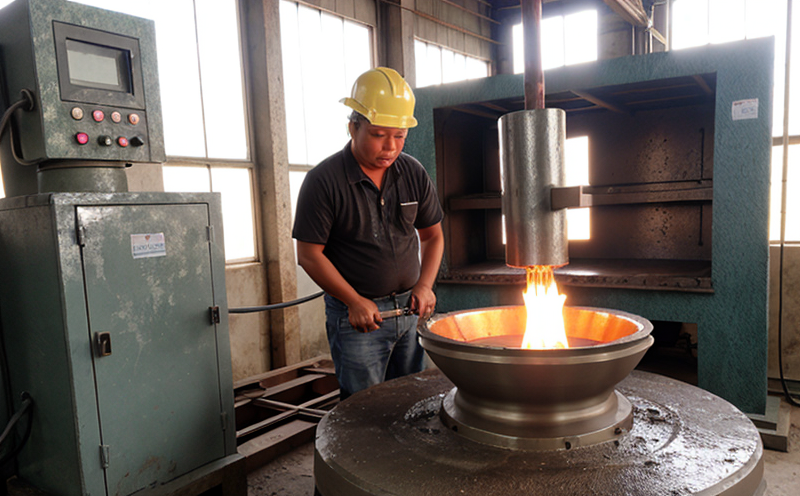ISO 8071 Moisture Content Testing of Foundry Sand
The ISO 8071 standard specifies the method for determining the moisture content in foundry sands used in casting and foundry processes. This testing is crucial to ensure optimal sand properties, which directly impact the quality and performance of castings produced. Proper moisture control is essential because variations in humidity can lead to shrinkage cracks, porosity, and other defects that compromise the integrity of the final product.
The testing method outlined in ISO 8071 involves drying a representative sample of foundry sand at a specific temperature until it reaches a constant weight. The difference between the initial mass of the sample before drying and its mass after reaching equilibrium is directly proportional to the moisture content present. This standard also provides guidance on preparing samples, including the use of sieves to ensure that only particles within an appropriate size range are tested.
Accuracy in moisture testing ensures consistent quality across batches and facilitates process control. Quality managers can rely on these test results to make informed decisions about sand treatment processes such as drying or conditioning. Compliance officers need this data to verify adherence to industry standards, while R&D engineers use it to optimize new casting techniques.
Understanding the moisture content is particularly important in foundry practices because the properties of sand are influenced by its water content. For instance, too much moisture can lead to poor flowability and increased segregation during pouring, whereas insufficient moisture may result in excessive shrinkage during cooling. By adhering to ISO 8071, foundries ensure that their processes meet international quality standards.
- Ensures Consistent Quality: Moisture content testing helps maintain uniform properties of the sand used throughout production runs.
- Facilitates Process Control: Real-time monitoring of moisture content aids in adjusting drying or conditioning processes as needed.
- Supports Compliance: Adherence to international standards like ISO 8071 ensures that foundries meet regulatory requirements.
- Optimizes Casting Performance: Precise control of moisture content can prevent defects such as porosity and shrinkage cracks in castings.
The test procedure outlined in ISO 8071 is straightforward yet critical. Specimens are prepared using sieves to ensure only particles within the specified size range are tested, then weighed before drying at a precise temperature until constant weight is achieved. The difference between pre-drying and post-drying weights determines the moisture content percentage.
Proper sample preparation is essential for accurate results. Samples should be representative of the entire batch or lot being tested to ensure that the test reflects the overall quality of the sand used in production. This involves careful sieving, mixing, and taking a subsample from the mixture. Once dried, the sample must be weighed again to calculate moisture content.
The ISO 8071 standard also provides specific drying temperatures suitable for different types of foundry sands. For example, silica-based sands may require higher temperatures due to their lower water vapor retention compared to chlorides or zeolites. Understanding these nuances helps in selecting the appropriate drying conditions for each type of sand.
Accuracy is paramount when performing ISO 8071 moisture content tests. Precision balances and accurate thermometers are indispensable tools. The use of a balance with a capacity suitable for weighing the sample ensures that small changes in weight can be accurately measured, while a thermometer calibrated to the specified drying temperature guarantees consistent results.
Quality assurance is vital in maintaining consistent product quality. By regularly performing ISO 8071 tests, foundries can identify trends and address any deviations from target moisture content early on. This proactive approach not only improves product quality but also enhances customer satisfaction by delivering reliable castings consistently.
Industry Applications
The application of ISO 8071 moisture content testing extends beyond foundries to various sectors where precision in material properties is crucial. In the automotive industry, for instance, consistent casting quality ensures that parts meet stringent performance and safety standards. Aerospace manufacturers rely on accurate sand testing to ensure critical components are free from defects that could compromise flight safety.
In construction, concrete mixtures often involve sand as a key component, and moisture control is vital to achieve the desired workability and strength characteristics. In agriculture, precision in soil moisture content can optimize crop yields by ensuring optimal hydration for plants without overwatering or under-watering.
Eurolab Advantages
EuroLab is dedicated to providing top-tier testing services tailored specifically to meet the needs of industrial manufacturing and processing sectors. Our expertise in ISO 8071 moisture content testing ensures that foundries receive reliable, accurate results every time.
- Comprehensive Expertise: Our team consists of seasoned professionals with deep knowledge of both international standards and local regulations.
- State-of-the-Art Facilities: We utilize cutting-edge equipment to ensure precise measurements and consistent results.
- Client Satisfaction: Our commitment to quality service leads to repeat business and strong client relationships.





